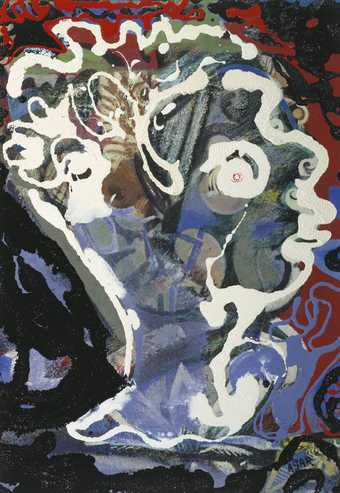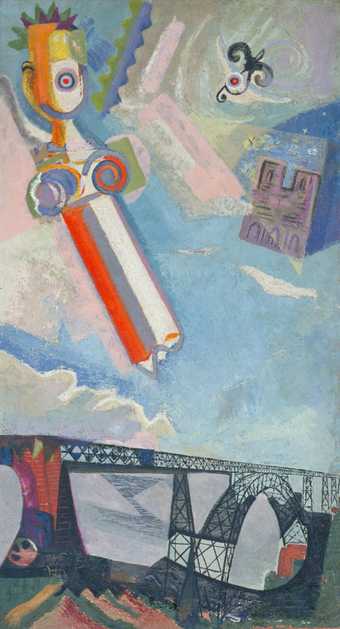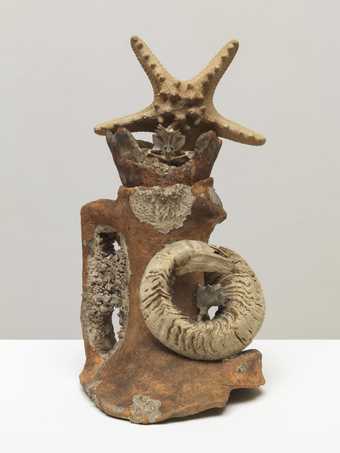
Not on display
- Artist
- Eileen Agar 1899–1991
- Medium
- Gouache and leaf on paper
- Dimensions
- Support: 210 × 275 mm
frame: 330 × 390 × 20 mm - Collection
- Tate
- Acquisition
- Purchased 1976
- Reference
- T02064
Summary
Eileen Agar often made collages and in this picture she added a leaf to a gouache. As in her painting Autobiography of an Embryo (Tate T5024), Agar was exploring the themes of life, death, the passing of time and seasonal cycles. She uses a single, simple image to encompass a range of universal themes. Although it looks abstract, the collage shows a mechanical reaper cutting a crop on a farm, a metaphor for the end of life. She described and explained the collage in 1978:
The leaf came from a 'dry garden', a book I have which dries and preserves leaves pressed between special paper. It was dead originally when used for the collage, but it was one I must have picked myself. The whole watercolour was intended to suggest a symbolic reaper with the flailing movement of the scythe-like concentric forms. The title indeed relates to time, the seasons and especially death the Great Reaper. The dead leaf being the hub of the whole.
Time is expressed more especially by the large black sun, which at the bottom left hand corner is sinking. The little triangle suggests a country roof and the two black spots two people riding the machine. There is also the outline of the back of a cow, with the small forelegs implanted on either side of the stem of the leaf.
(Conversation of 29 July 1978, quoted in Illustrated Catalogue of Acquisitions 1976-78, p.27.
The painting is mounted on blue paper and the frame was a 'found' object painted in silver and gold. Although the artist denied that the framing had any 'special significance' she agreed that the mount and frame work with the painting to evoke secondary associations, for example the blue and gold can be linked to the sky and the sun.
The picture was first exhibited in 1965 when Marlborough Fine Art reviewed the avant-garde of the 1930s in the exhibition Art in Britain 1930-1940.
Further reading:
Ann Simpson, with David Gascoyne and Andrew Lambirth, Eileen Agar 1899-1991, exhibition catalogue, Scottish National Gallery of Modern Art, Edinburgh 1999, no.47, reproduced p.78.
Illustrated Catalogue of Acquisitions 1976-78, Tate Gallery, London 1978, p.27, reproduced p.27.
Chloe Johnson
June 2002
Does this text contain inaccurate information or language that you feel we should improve or change? We would like to hear from you.
Display caption
The starting point for this composition was a dried leaf, which Agar had specially preserved within the pages of a book. The ageing leaf may also have suggested the themes evoked in the painting, as described by Agar: ‘The whole watercolour was intended to suggest a symbolic reaper with the flailing movement of the scythe-like concentric forms. The title indeed relates to time, the seasons and especially death the Great Reaper. The dead leaf being the hub of the whole.’
Gallery label, July 2011
Does this text contain inaccurate information or language that you feel we should improve or change? We would like to hear from you.
Catalogue entry
T02064 THE REAPER (1938)
Inscribed ‘AGAR’ b.r.
Gouache and collaged leaf on paper, 8 1/4 × 11 (21 × 28)
Purchased from the artist through the New Art Centre (Grant-in-Aid) 1976
Exh: Art in Britain 1930–40, Marlborough Fine Art, March–April 1965 (3); Eileen Agar, Commonwealth Art Gallery, September–October 1971 (14); Eileen Agar, New Art Centre, June–July 1976 (23)
The following note was supplied by Eileen Agar, in response to a letter from the compiler and followed up in conversation on 29 July 1978.
'The leaf came from a “dry garden”, a book I have which dries and preserves leaves pressed between special paper. It was dead originally when used for the collage, but it was one I must have picked myself. The whole watercolour was intended to suggest a symbolic reaper with the flailing movement of the scythe-like concentric forms. The title indeed relates to time, the seasons and especially death the Great Reaper. The dead leaf being the hub of the whole.
‘Time is expressed more especially by the large black sun, which at the bottom left hand corner is sinking. The little triangle suggests a country roof and the two black spots two people riding the machine. There is also the outline of the back of a cow, with the small forelegs implanted on either side of the stem of the leaf.’
The gouache is mounted on a blue ground, and the frame originally chosen by the artist was an old one, painted in silver and gold. Asked whether the mount and frame (the gilding is now somewhat worn and faded) were intended to form part of the total image, Miss Agar alluded to her practice of using ‘found’ elements at this period: ‘The frame... was more or less in that state when I found it, and though I considered changing it for a newer one, I decided against it. I mounted it on a piece of blue paper at the time. Otherwise than its seeming to belong to the watercolour, it had no special significance.’ She agreed, however, that insofar as both could evoke secondary associations with the image - for example of the sun or sky - the frame and mount formed part of it.
‘The Reaper’ has always been in the artist's possession and was not exhibited before the 1965 Marlborough Fine Art show Art in Britain 1930–1940.
Published in:
The Tate Gallery 1976-8: Illustrated Catalogue of Acquisitions, London 1979
Explore
- abstraction(8,615)
-
- from recognisable sources(3,634)
- agricultural(1,066)
-
- farm(852)
- universal concepts(6,387)
-
- time(679)
- birth to death(109)
- agriculture and fishing(1,275)
-
- farmer(41)
You might like
-
Eileen Agar Head of Dylan Thomas
1960 -
Eileen Agar Three Symbols
1930 -
Eileen Agar Angel of Anarchy
1936–40 -
Eileen Agar Marine Object
1939




